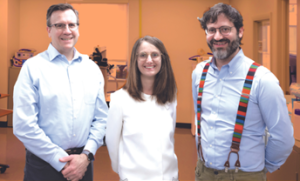
Image from left to right: Drs. Weber, Pirondini, and Capogrosso
By Cristina D’Imperio
More than a decade ago, college student Heather Rendulic suffered a series of five brain bleeds over an 11-month period. An active runner and horseback rider, Rendulic had to relearn how to walk. The left half of her body had become paralyzed.
Globally, one quarter of adults over the age of 25 will experience a stroke. Approximately 75% of all people who suffer a stroke will also experience loss of motor control in an arm and hand. Six months after a stroke, or the “chronic stage,” there are no effective federally approved treatments for paralysis in the U.S.
A team of Pittsburgh-based researchers are using electric stimulators to change that.
In 2021, Douglas Weber, PhD, McGowan affiliated faculty; Elvira Pirondini, PhD, Assistant Professor of Neural Engineering and Physical Medicine and Rehabilitation; and Marco Capogrosso, PhD, Assistant Professor in the Department of Neurological Surgery at the University of Pittsburgh, began a collaboration at Pitt’s Neural Engineering Labs.
Drs. Weber, Pirondini, and Capogrosso worked alongside a team of researchers to begin the first clinical trial to use spinal implants to treat arm and hand paralysis in stroke patients. One of the patients they enrolled was Heather Rendulic.
Shortly after the trial began, surgeons threaded two small electrodes through a small incision in Rendulic’s upper back. The electrodes were positioned in her neck, in the epidural space over the spinal cord, in order to engage intact neural circuits. Prior to the surgery, Rendulic’s left arm was all but paralyzed.
After the surgery, Rendulic was able to fully open and close her fists, raise her arms above her head, and complete everyday tasks that had previously been impossible.
The technology implanted in Rendulic has also been used in patients experiencing high-grade, persistent pain, as well as patients who are paralyzed from the waist down. However, restoring the dexterity of a hand and the full range of motion to an arm comes with a unique set of challenges.
“We discovered that electrical stimulation of specific spinal cord regions enables patients to move their arm in ways that they are not able to do without the stimulation,” says Dr. Capogrosso. The stimulation occurs only when patients are trying to use their arm or hand.
“The sensory nerves from the arm and hand send signals to motor neurons in the spinal cord that control the muscles of the limb,” Dr. Weber explains in an interview with PittMed. “By stimulating these sensory nerves, we can amplify the activity of muscles that have been weakened by stroke. Importantly, the patient retains full control of their movements.”
Surprisingly, researchers also learned from the trial that the implants could prompt longer-lasting mobility improvements. “We found that after a few weeks of use,” states Dr. Capogrosso, “some of these improvements endure when the stimulation is switched off, indicating exciting avenues for the future of stroke therapies.”
Rendulic, too, is optimistic. “That very first day, none of us knew for sure if it was going to work, or how it would feel if it did,” she says. “But that very first day in the lab, I opened and closed my hand for the first time in the nine years since my stroke. My husband and my mom were there, and when I opened that hand, there were just tears of joy.”
Today, as she continues to work with Drs. Weber, Pirondini, and Capogrosso, Rendulic notes, “The future of this is so exciting. […] I wholeheartedly believe this technology can change millions of lives.”
Read more at the New York Times, CNN, NPR, and the BBC.
Read the story at PittMed.
Find the study at Nature Medicine.
